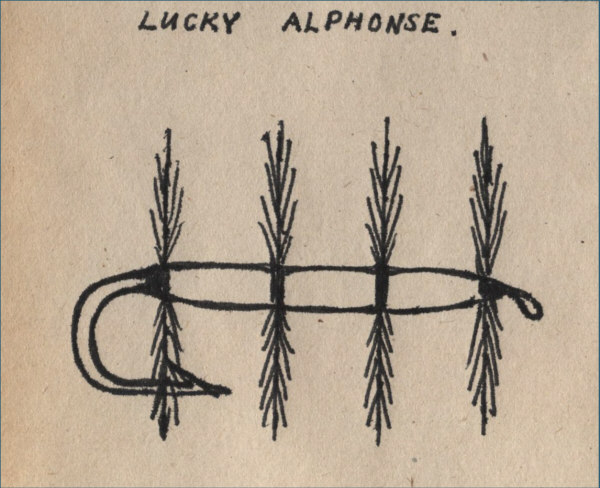It can imitate just about any fly. It even works, dressed on a size 6 or 8 hook, as a Mayfly!
On the river Trent, downstream of Beeston Weir, it once caught me 80 chub in a few hours on a very hot day back in the 1970's.
In size 14 it will work during an olive hatch although to our eyes it looks nowt like the real thing. For sedge flies it is an excellent representation and for many terrestrials it makes a fake that the trout and grayling often decide is acceptable. On a "dry fly only" water it is a mainstay in fast violent water, no need to go below the meniscus with a Klinkhåmer Special or derivative, the Double Badger will let you see what is going on and will bring the fish up for you.
When the trout have worn out the peacock herl with their teeth and the fly may look a little the worse for wear, don't throw it away. Put it in your hat band for this special occasion...
During any of the 1 to 2 hour blizzards of Caenis making their presence felt, a lot is going on at once. The nymphs are emerging, the duns are hatching, swirls of Caenis spinners are mating in the air over the water and nearby, as fast as they can and... the spinners are coming back to the water. It is a swirling chaos of activity. The fish are rising and many anglers are beaten into believing that Caenis do not present a reasonable opportunity for success. Even if you could tie a perfect fake on a size 26 hook, why would the trout eat your single offering when there are so many real ones? Yours would be hopelessly lost. Persevere by all means with this approach but you will be hoping for a dumb fluke of a chance. But there is a way that gives you a real chance. In fact it gives you many, very good chances.
Watching the fish rise during a Caenis blizzard, you will see some of the very best fish making a very distinctive rise form. These fish hang at an angle in the water and with gaping mouths simply slide up and down through the surface of the water, maintaining their angled pose without levelling off between rises. Close observation shows that they are engulfing rafts of Caenis (mainly dead and dying spinners) that are all tangled up together.
 Years ago the late Richard Walker invented a fly for such occasions that he called "Lucky Alphonse". Basically it consisted of up to half a dozen little white hackled dry flies tied on a size 12 long shank hook.
Years ago the late Richard Walker invented a fly for such occasions that he called "Lucky Alphonse". Basically it consisted of up to half a dozen little white hackled dry flies tied on a size 12 long shank hook.
It's a fly that does work but my it is awkward to tie and takes a while for each one. Instead I use one of my worn out Double Badgers that live in my hat band for just such opportunities. It works beautifully so don't chuck 'em away. Save them for a busy evening. Turn a struggle for a bit of good luck into a clear, workable strategy that will bring you success.
Here's how to make the Double Badger:
 |
Put the hook in the vice masking the point, and make a bed of brown thread starting behind the eye finishing at the bend
|
 |
Prepare a badger hackle and tie it in at the bend
|
 |
Here's the hackle almost tied in, two more turns to go
|
Wind the hackle back to the thread and then wind the thread through the hackle tying it in securely
|
 |
Now tie in a strand of peacock herl immediately in front of this aft hackle
|
 |
Leave the thread dangling where you tied in the peacock herl and wind a body by close turns of the herl up to the front and then back again to the thread and tie in the herl
|
 |
Rib the herl with open turns of the thread up to the front of the body and make a tiny bed for the front hackle
|
 |
Tie in the front hackle taking the thread back to the front of the body and making a bed for the hackle turns as you go
|
 |
Wind the hackle and tie it in taking the thread through the hackle to make a whip finish just against the eye, varnish the whip finish with clear nail polish, clean out the eye of the hook whilst the varnish is still wet (the left-over, hackle point, from your hackle pliers, makes a good pull-through) and there you have it - The Double Badger!
You can read about the inventing of the Double Badger in Angling with the Fly by J N Watson. |
Regular Rod




You've got to admire Walkers' orginal thought. Good post RR. The DB seems to have lost its place in the box to the Griffith Gnat of late. I fished from the age of 8 until leaving primary school at 11 with just the DB, grey duster and dogsbody mayfly. The DB was my grayling fly.
ReplyDelete